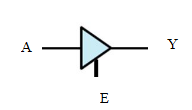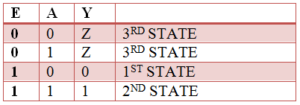A 3-state buffer gate (also known as a tri-state buffer) is a type of logic gate that can operate in three different states: 1 (High), 0 (Low), and High Impedance (Z). The third state, high impedance, essentially disconnects the output from the circuit, making it behave as if the output is not connected at all. This feature is useful in bus systems, where multiple devices share the same data line, but only one should drive the line at a time.
Working:
- Input (A): The value the buffer passes to the output when enabled.
- Enable (EN): A control signal that determines whether the buffer is active or in the high-impedance state.
States:
- EN = 1: The buffer is enabled, and the output follows the input (A). If A = 1, the output is 1; if A = 0, the output is 0.
- EN = 0: The buffer is disabled, and the output goes into a high-impedance state (Z), effectively removing the output from the circuit.


Applications:
- Bus systems: In situations where multiple devices share the same communication line, a tri-state buffer allows only one device to drive the line at a time, preventing signal conflicts.
- Memory management: Tri-state buffers help control data flow from memory to CPU by enabling or disabling memory sections for access.
0 Comments